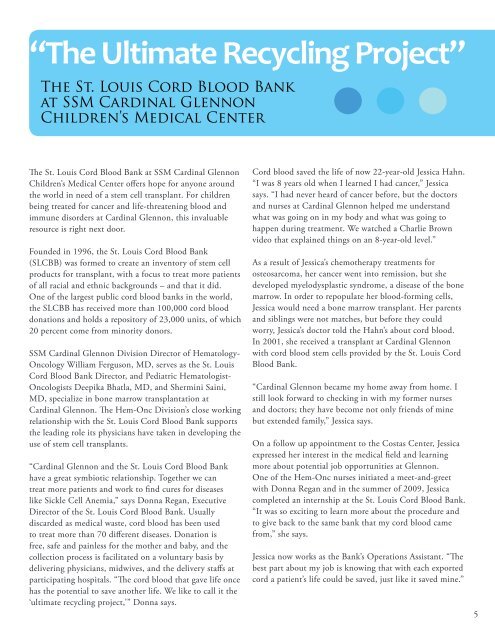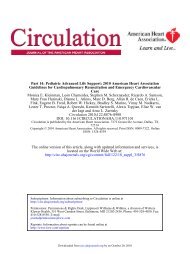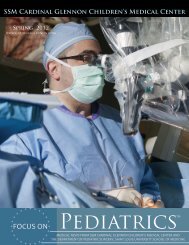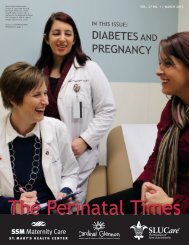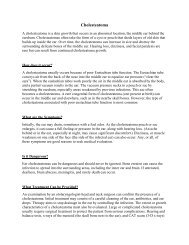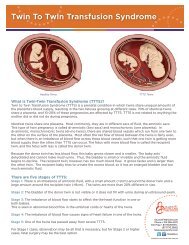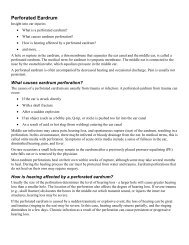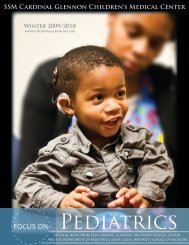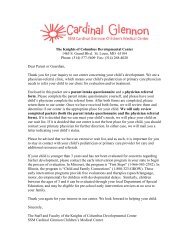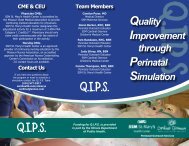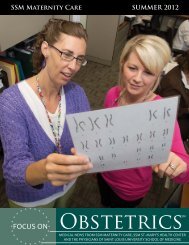Spring 2011 - SSM Cardinal Glennon Children's Medical Center
Spring 2011 - SSM Cardinal Glennon Children's Medical Center
Spring 2011 - SSM Cardinal Glennon Children's Medical Center
Create successful ePaper yourself
Turn your PDF publications into a flip-book with our unique Google optimized e-Paper software.
“The Ultimate Recycling Project”The St. Louis Cord Blood Bankat <strong>SSM</strong> <strong>Cardinal</strong> <strong>Glennon</strong>Children’s <strong>Medical</strong> <strong>Center</strong>The St. Louis Cord Blood Bank at <strong>SSM</strong> <strong>Cardinal</strong> <strong>Glennon</strong>Children’s <strong>Medical</strong> <strong>Center</strong> offers hope for anyone aroundthe world in need of a stem cell transplant. For childrenbeing treated for cancer and life-threatening blood andimmune disorders at <strong>Cardinal</strong> <strong>Glennon</strong>, this invaluableresource is right next door.Founded in 1996, the St. Louis Cord Blood Bank(SLCBB) was formed to create an inventory of stem cellproducts for transplant, with a focus to treat more patientsof all racial and ethnic backgrounds – and that it did.One of the largest public cord blood banks in the world,the SLCBB has received more than 100,000 cord blooddonations and holds a repository of 23,000 units, of which20 percent come from minority donors.<strong>SSM</strong> <strong>Cardinal</strong> <strong>Glennon</strong> Division Director of Hematology-Oncology William Ferguson, MD, serves as the St. LouisCord Blood Bank Director, and Pediatric Hematologist-Oncologists Deepika Bhatla, MD, and Shermini Saini,MD, specialize in bone marrow transplantation at<strong>Cardinal</strong> <strong>Glennon</strong>. The Hem-Onc Division’s close workingrelationship with the St. Louis Cord Blood Bank supportsthe leading role its physicians have taken in developing theuse of stem cell transplants.“<strong>Cardinal</strong> <strong>Glennon</strong> and the St. Louis Cord Blood Bankhave a great symbiotic relationship. Together we cantreat more patients and work to find cures for diseaseslike Sickle Cell Anemia,” says Donna Regan, ExecutiveDirector of the St. Louis Cord Blood Bank. Usuallydiscarded as medical waste, cord blood has been usedto treat more than 70 different diseases. Donation isfree, safe and painless for the mother and baby, and thecollection process is facilitated on a voluntary basis bydelivering physicians, midwives, and the delivery staffs atparticipating hospitals. “The cord blood that gave life oncehas the potential to save another life. We like to call it the‘ultimate recycling project,’” Donna says.Cord blood saved the life of now 22-year-old Jessica Hahn.“I was 8 years old when I learned I had cancer,” Jessicasays. “I had never heard of cancer before, but the doctorsand nurses at <strong>Cardinal</strong> <strong>Glennon</strong> helped me understandwhat was going on in my body and what was going tohappen during treatment. We watched a Charlie Brownvideo that explained things on an 8-year-old level.”As a result of Jessica’s chemotherapy treatments forosteosarcoma, her cancer went into remission, but shedeveloped myelodysplastic syndrome, a disease of the bonemarrow. In order to repopulate her blood-forming cells,Jessica would need a bone marrow transplant. Her parentsand siblings were not matches, but before they couldworry, Jessica’s doctor told the Hahn’s about cord blood.In 2001, she received a transplant at <strong>Cardinal</strong> <strong>Glennon</strong>with cord blood stem cells provided by the St. Louis CordBlood Bank.“<strong>Cardinal</strong> <strong>Glennon</strong> became my home away from home. Istill look forward to checking in with my former nursesand doctors; they have become not only friends of minebut extended family,” Jessica says.On a follow up appointment to the Costas <strong>Center</strong>, Jessicaexpressed her interest in the medical field and learningmore about potential job opportunities at <strong>Glennon</strong>.One of the Hem-Onc nurses initiated a meet-and-greetwith Donna Regan and in the summer of 2009, Jessicacompleted an internship at the St. Louis Cord Blood Bank.“It was so exciting to learn more about the procedure andto give back to the same bank that my cord blood camefrom,” she says.Jessica now works as the Bank’s Operations Assistant. “Thebest part about my job is knowing that with each exportedcord a patient’s life could be saved, just like it saved mine.”5


